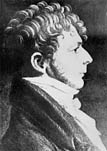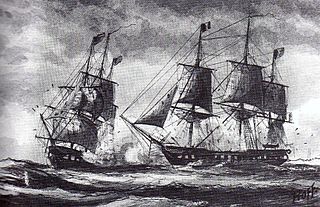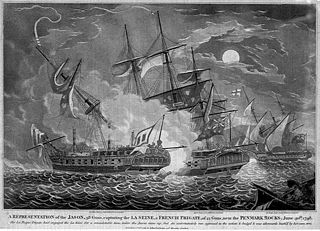
The Quasi-War was an undeclared naval war fought from 1798 to 1800 between the United States and the French First Republic, primarily in the Caribbean and off the East Coast of the United States. The ability of Congress to authorize military action without a formal declaration of war was later confirmed by the Supreme Court and formed the basis of many similar actions since, including American participation in the Vietnam War and the 1991 Gulf War.

William Bainbridge was a Commodore in the United States Navy. During his long career in the young American Navy he served under six presidents beginning with John Adams and is notable for his many victories at sea. He commanded several famous naval ships, including USS Constitution, and saw service in the Barbary Wars and the War of 1812. Bainbridge was also in command of USS Philadelphia when she grounded off the shores of Tripoli in North Africa, resulting in his capture and imprisonment for many months. In the latter part of his career he became the U.S. Naval Commissioner.

Andrew Sterett[8] was an officer in the United States Navy during the nation's early days. He saw combat during the Quasi-War with France and in the Barbary Wars, commanding the schooner USS Enterprise in both conflicts.

Stephen Decatur Sr. was an American privateer in the Revolutionary War and later in the Quasi-War was commissioned as a captain in the United States Navy. He was the father of Stephen Decatur Jr.

USS Constellation was a nominally rated 38-gun wooden-hulled, three-masted frigate of the United States Navy.
The first USS Montezuma was a merchant ship built in Virginia in 1795. United States Navy acquired her during the Quasi-War with France and retained her name.

L'Insurgente was a 40-gun Sémillante-class frigate of the French Navy, launched in 1793. During the Quasi War with the United States, the United States Navy frigate USS Constellation, with Captain Thomas Truxtun in command, captured her off the island of Nevis. After her capture she served in the United States Navy as USS Insurgent, patrolling the waters in the West Indies. In September 1800 she was caught up in a severe storm and was presumed lost at sea.
USS Retaliation was the French privateer Croyable, built in Maryland, that then operated out of Santo Domingo. Delaware captured her on 7 July 1798 off New Jersey. She then served in the United States Navy during Quasi-War with France. Two French frigates recaptured her on 20 November 1798. The French Navy took her into service as Magicienne. However, Merrimack captured her on 28 June 1799. She served in the US Navy in the Caribbean briefly, before arriving in Philadelphia in August. She was paid off there and sold on 29 November.

Commodore Arthur Sinclair was an early American naval hero, who served in the U.S. Navy during the Quasi-War with France, the First Barbary War and in the War of 1812. His three sons also served in the Navy; they resigned in 1861, however, to serve in the Confederate Navy.
USS Merrimack, was a ship launched by an Association of Newburyport Shipwrights and presented to the Navy in 1798. She was the first ship of the Navy to be named for the Merrimack River. She saw action in the Quasi-War.

Seine was a 38-gun French Seine-class frigate that the Royal Navy captured in 1798 and commissioned as the fifth-rate HMS Seine. On 20 August 1800, Seine captured the French ship Vengeance in a single ship action that would win for her crew the Naval General Service Medal. Seine's career ended in 1803 when she hit a sandbank near the Texel.

The Franco-American alliance was the 1778 alliance between the Kingdom of France and the United States during the American Revolutionary War. Formalized in the 1778 Treaty of Alliance, it was a military pact in which the French provided many supplies for the Americans. The Netherlands and Spain later joined as allies of France; Britain had no European allies. The French alliance was possible once the Americans captured a British invasion army at Saratoga in October 1777, demonstrating the viability of the American cause. The alliance became controversial after 1793 when Britain and Revolutionary France again went to war and the U.S. declared itself neutral. Relations between France and the United States worsened as the latter became closer to Britain in the Jay Treaty of 1795, leading to an undeclared Quasi War. The alliance was defunct by 1794 and formally ended in 1800.
Volontaire was a 40-gun Virginie-class frigate of the French Navy.
Events from the year 1799 in the United States.

The Sémillante class was a type of 12-pounder, 32-gun frigate of the French Navy, designed by Pierre-Joseph Pénétreau.

USS Constellation vs L'Insurgente, or the action of 9 February 1799, was a single-ship action fought between frigates of the French Navy and the United States Navy during the Quasi-War, an undeclared war that lasted from 1798 to 1800. The battle resulted in USS Constellation's capture of L'Insurgente, after an intense firefight in which both sides exchanged heavy broadsides and musket fire.

HMS Aurora was a 28-gun Enterprise-class sixth-rate frigate of the Royal Navy, that saw service during the American and French Revolutionary wars, and the Napoleonic Wars. Designed to carry a complement of 200 men, she was armed with a main battery of twenty-four 9-pound guns.

The Capture of La Croyable, or the Action of July 7, 1798, occurred when the French privateer schooner La Croyable was taken by the American sloop-of-war USS Delaware on 7 July 1798 during the Quasi-War. The engagement resulted in the first capture of any ship by the United States Navy, which had been formed just months before the action.









